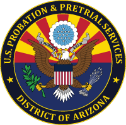Workforce Workshop 101
The workforce workshop focuses on how to address and overcome barriers to help a person on supervision re-enter the workforce. A couple examples of these barriers are how to address criminal history on an application and during a job interview, how to start an employment search, job searching techniques, and where to go for employment assistance. The workshop is concluded by mock interviews and available employment opportunities. Workshop availability is different dependent on each location.
Please contact your U.S. Probation Officer for further information about the workforce workshop near you:
Resources for Job Seekers
- Bureau of Labor Statistics
- Occupational Projections
- Occupational Outlook
- Indeed
- Kuder
- Craigslist
- Career One Stop
- Careers
- Career Builder
- Nation Job
- Top Tech Jobs
- Job Hunt
- Job Star
- True Careers
- Monster
- ZipRecruiter
Attachments for Job Seekers
- Employment Log
- Explaining a felony conviction
- Interviewing tips
- Resume Worksheet
- Chronological Resume Sample
- Sample Functional Resume
- Sample Job Application
- Sample Thank You Letter
General Equivalency Diploma (GED) Services
- Arizona Department of Education
- U.S. Department of Education Database of Accredited Postsecondary Institutions and Programs
- Tests of the General Educational Development (GED) were established in 1942 to help returning World War II veterans finish their studies and earn a high school credential. Recognized throughout North America by employers and institutions of higher learning, the GED program served as a bridge to education and employment opportunities for millions of adults since 1942. An estimated 12.6 million people have earned high school equivalency diplomas since the program began.
- Today, GED tests measure the academic skills and knowledge students are expected to acquire during four years of high school. The GED test battery consists of five tests: writing skills, social studies, science, interpreting literature and the arts, and mathematics.
- The GED testing program is jointly administered by the GED Testing Service of the American Council on Education and each participating state department of education. There are nearly 3,500 official GED Testing Centers in the U.S., Canada, and overseas. Source: American Council on Education.
- What are the Score Requirements?
A minimum standard score of 2250, which is an average of 450 on the five tests, with no score below 410, is necessary to qualify for the certificate. Scores are valid for two years from test date. - What do the GED Tests Measure?
Language Arts, Reading: Literary Texts (poetry; drama: prose fiction before 1920, between 1920-1960, and after 1960) (75%); Nonfiction Prose (25%). Language Arts, Writing Part I: Organization (15%); Sentence Structure (30%); Usage (30%); Mechanics (25%); Part II: Essay (45-minute direct writing exercise). Mathematics: Number Operations and Number Sense (25%); Measurement and Geometry (25%); Data Analysis, Statistics, and Probability (25%); Algebra, Functions, and Patterns (25%). Science: Life Science (45%); Earth and Space Science (20%); Physical Science (Chemistry and Physics) (35%). Social Studies: National History (25%); World History (15%); Economics (20%); Civics and Government (25%); Geography (15%).
Resources for Employers
- Federal Bonding Program
- Federal Bonding Brochure
- Federal Bonding Highlights
- Tax Incentives for Employers
Training for Employers and/or the Community
Workforce Development Specialist (WDS) This training curriculum was developed by the National Institute of Corrections and the National Career Development Association (NCDA). This curriculum trains participants in twelve specific competencies and their related skills to assist individuals under supervision make informed decisions about jobs and career paths. Contact Quincy Fountain for more information at 314-244-6746.
